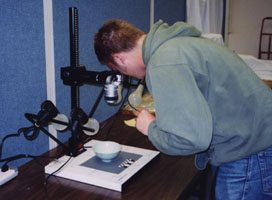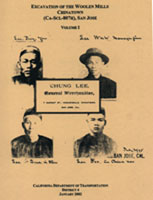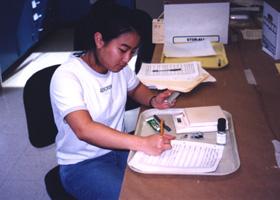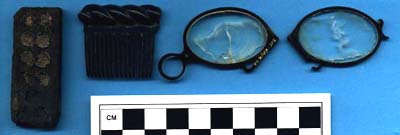
Ezra Erb using our photo documentation setup to photograph a celadon bowl.
Sarah Puckitt of History San Jose visited our class this week, and talked about photo documentation of artifacts. Her talk included information about photographing single artifacts and also the place of photo documentation in collections management as a whole. Sarah is the Visual Resources Manager at History San Jose, and brought several examples of photo documentation work she has undertaken there. After this talk, we set up our photo documentation equipment in the lab. Students are beginning to photograph artifacts as part of the work associated with their project research and presentation. Already many of the lighting and framing tips given by Sarah are proving to be useful! Light can be used to highlight details that are difficult to see on the artifact, such as faint decoration or low relief. Photo documentation is important in archaeological work, in providing a visual record that can be consulted by others interested in the collection, when physical access to artifacts is difficult or impossible. Good photo documentation is also an integral part of the long-term conservation and preservation of artifact collections, because a good visual record minimizes the need to handle artifacts, and therefore decreases risks of loss or breakage.

Report of the Excavation of the Woolen Mills Chinatown. One of its principal authors, Dr. Rebecca Allen, came to talk with students in the class about the Market Street collection.
Dr. Rebecca Allen took some time out of her busy schedule to visit our class during this Friday’s lab session. She was one of the archaeologists responsible for the excavation of the Woolen Mills Chinatown in San Jose. Several of the students in this class are pursuing research projects that involve comparisons between the artifacts recovered from the Market Street and Woolen Mills sites, in order to address comparative questions about life in these two settlements. These students are cataloging and analyzing artifacts from the Market Street Chinatown collection, and comparing their results with data presented in the Woolen Mills report, Volume 1 of which is pictured to the left. Dr. Allen was very helpful in suggesting further readings and resources for students to use, as well as helping to answer some challenging questions about artifact identification and interpretation.
Artifact of the Week

Artifacts 85-31/33-107, 85-31/21-2, and 85-31/21-4.
And speaking of artifact identification and interpretation… One of the students in the class is examining medicinal bottles and medicinal practices as represented in artifacts from the Market Street Chinatown. This is not quite as straightforward as it may sound, as the definition of medicinal practices is not a simple one. Pictured here are fragments or examples of bottles that provoked a lot of questions. From left to right, these are a soda water bottle, a bottle that contained a compound “For the Hair”, and a bottle labeled “Aromatic Schnapps.” None of these artifacts are clearly medicinal in nature, but Schnapps was and is considered a health-fortifying drink by some people, hair tonics contribute to “healthy” hair, and soda water was and is often consumed to quell stomach upset. Questions about these artifacts demonstrate a real challenge of archaeological description. Decisions about how to catalog them involve substantial interpretive decisions. How would you classify these artifacts?





